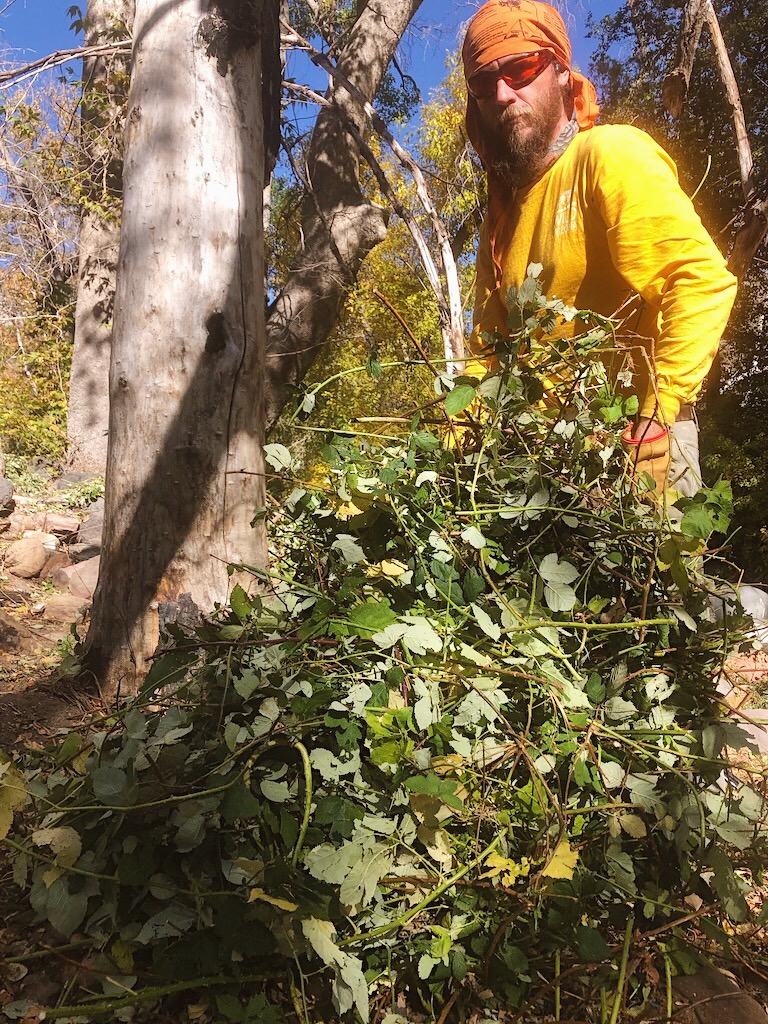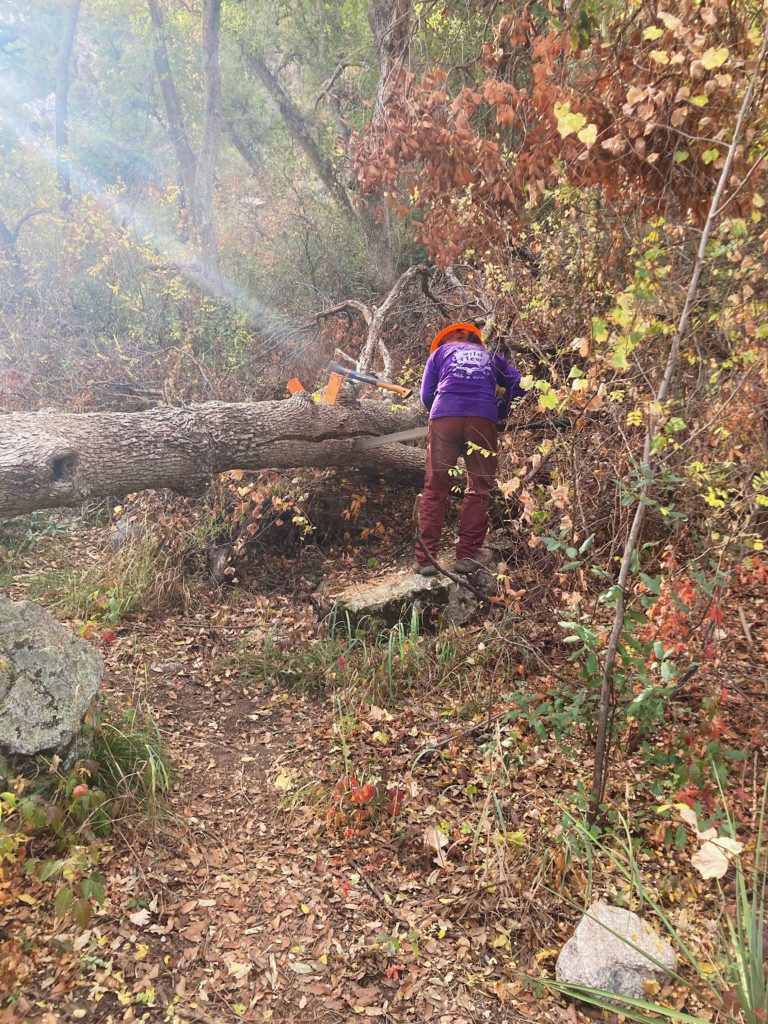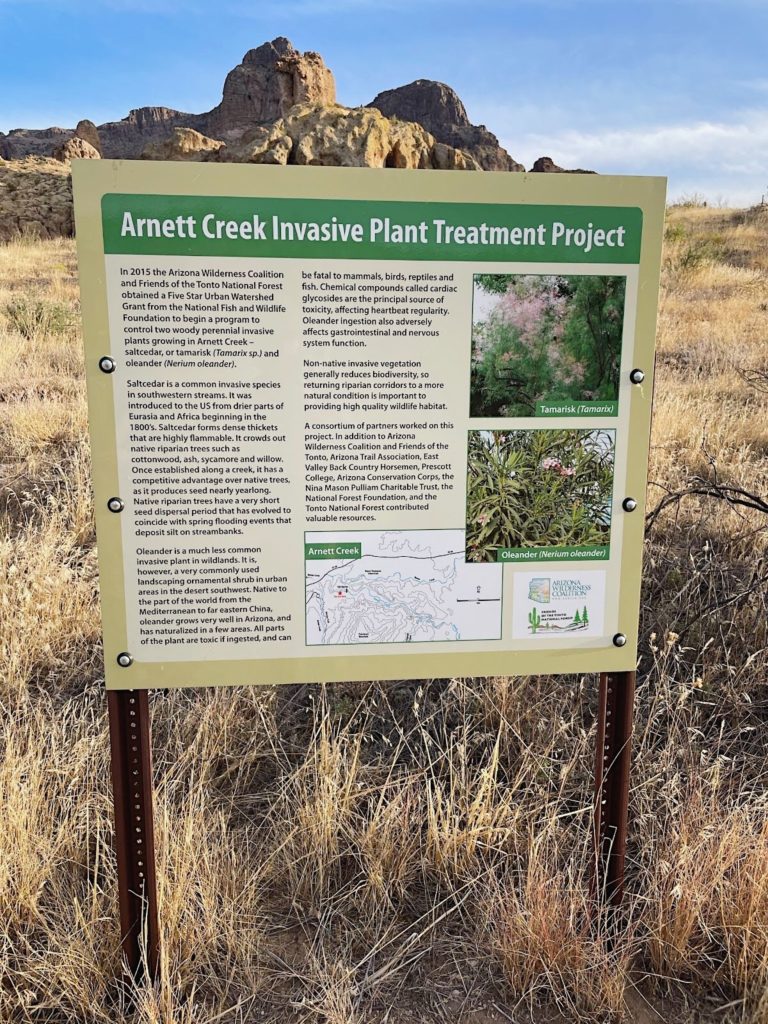Article written by: Dexter Kopas, Field Crew Leader
Howdy, WildAZ friends! Welcome to another round of exciting updates on the work of WildAZ’s Wild Stew Field Crew. This hitch the crews were spread out on three different projects around central Arizona. Nico’s jolly band of stewards was close to home restoring the Romero Trail in the Catalina Mountains, while groups led by Sam and yours truly removed a host of invasive plant species along creeks Arnett and Fossil, respectively.
Out on the Fossil Creek, our crew Sage Bradford, Ollie Linde, Joseph Cofresi, and myself joined forces with Friends of the Verde River (FVR) and Coconino National Forest to help restore the ecosystem near the largest naturally occurring springs in the state. Our targets were Himalayan blackberry (Rubus armeniacus) giant reed (Arundo donax L.), and some tamarisk (Tamarix species).
After two and a half days with the blackberry, we backpacked out to our truck and trailer to a front country site further downstream on Fossil Creek. Luxurious compared to the backpacking accommodations. From here we spent 3 days in our trusty waders venturing down the creek in search of and treating giant reed and tamarisk. In our pleasant exploratory expedition through the maze of deep pools, horsetails, travertine dams, and flood debris, we found no tamarisk, but many stands of giant reed up to 15 feet tall. The main challenge was taking the long bamboo-like stalks out of the floodplain to where they are unlikely to reroot. We eventually found the best way was to fireline them, using the length of the pieces to our advantage to cover longer distances, often while standing in cooling rapid currents.

Himalayan blackberry can spread rapidly into undisturbed sunny areas, displacing native herbaceous plants and shrubs, according to the National Park Service. As mentioned in our last blog from our work in this area, giant reed not only takes over wherever it grows, it can also impact fire frequency and intensity, according to the USDA. Similarly, tamarisk impacts fire risk in Arizona’s wildlands. It’s also a particularly thirsty plant that sucks up water, lowering local water tables and leaving less along watercourses for native plants to drink, all while increasing soil salinity, too, according to the National Park Service.
Our hitch began with backpacking to Fossil Springs, where over 30 million gallons of water are discharged each day at a constant 70 °F. We set up our backcountry campsite near the remains of the hydroelectric dam that harnessed the powers of the water until it was decommissioned in 2005 to help restore the opportunities for bountiful habitat that the springs present. The next day we started removing and then applying small amounts of herbicide to the blackberry brambles that have taken over the main springs. It was a simpler task than a year ago, when the area was initially treated. With repeated efforts, soon the nearby native Arizona dewberry (Rubus arizonensis) will return to take its place.

There will be much more work to do in this area in the coming months for our crews and our partners at FVR and the Forest Service, and this writer could not be happier about that. It is truly a special place, where the desert gives way to a lush verdant garden, hiding a bounty of sights and sounds waiting to be discovered around the next bend.
So special is Fossil Creek, that in 2009 Wild Arizona (then Arizona Wilderness Coalition) collaborated with partners and stakeholders around the state in its successful designation by Congress as a Wild and Scenic River. Read our 2009 Fossil Creek WSR press release.
Meanwhile, tracing downstream around several bends of Fossil Creek, then down the Verde River and on down the Salt River until it meets the main Gila River, turning back up the Gila, up its tributary Queen Creek, and finally up along Arnett Creek, another band of Wild Arizona’s finest was engaging in a different bit of habitat restoration.
“This song of the waters is audible to every ear, but there is other music in these hills, by no means audible to all. To hear even a few notes of it you must first live here for a long time, and you must know the speech of hills and rivers.”
Aldo Leopold in his essay “Song of the Galivan.”

For the most part the water is not currently running in Arnett Creek, but residents of the town of Superior, Arizona know well its voice. They know its voice by the trees: ash, willow, and cottonwood. They know its voice by the travelers: hikers, bikers, and horse riders. And they know its voice by the good it brings: smiles, laughter, and the quiet gaze of curiosity.
For the past eight days, two of Wild Arizona’s crew have been busily working along creek corridors of Arnett and Telegraph Canyon. The majority of the time Kile and Sam spent re-treating small plants and saplings of a variety of invasive species: Tamarisk, Oleander, Tree of Heaven, and African Sumac. The current volume of invasives along the project site is relatively low. However, it was not always this way.
When Wild Arizona (aka Arizona Wilderness Coalition) and Friends of the Tonto began this project in 2015, several of the stream crossings were so choked with Tamarisk, that hikers were forced to push their way through the underbrush. A variety of vegetation management methods have been used in the last eight years: hand pulling, chainsawing, herbicide, and covering target plants with black plastic bags. The hard work has paid off. Besides a couple small thickets of Tree of Heaven, most of the invasive species are either gone or reduced to isolated resprouts.
Here are some work statistics from this most recent hitch of work:
- 4.4 miles of Arnett Creek retreated
- 0.7 miles of Telegraph Creek retreated
- 1.8 miles of Arnett Creek/Telegraph outside the project scouted for future projects
- 1.3 miles of Arnett Creek cleared of Cocklebur
- 118 data points taken for initial or retreatment of invasives plants

Although the Arnett and Telegraph Creek are in a much better place than a decade ago, there is still much to be done. First, both creek corridors need to be monitored and retreated for years to come. Second, although larger woody invasive species are in a manageable place, there is still an abundance of smaller, more herbaceous plants such as Malta Starthistle, cheatgrass, and cocklebur. All these are annual plants with a substantial seed bank that will each take multiple years of hand pulling or chemical treatment to effectively manage. Cocklebur has recently increased significantly in both Arnett and Telegraph Creek, perhaps in response to some of the larger woody invasives being removed. Because of its more recent insurgency, Cocklebur may prove to be an excellent target since its seed bank is less large. This hitch, Kile and Sam spent a day and a half hand pulling and bagging cockelbur, but much more remains to be done.
Residents of and visitors to Superior value Arnett and Telegraph for its relative lushness compared to the surrounding desert. Not only is the restoration of this creek important ecologically, but it provides an excellent place for community engagement and shared experiences.
Here’s to continuing the good fight for healthy plant and human communities!








